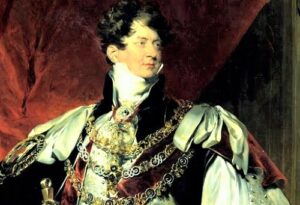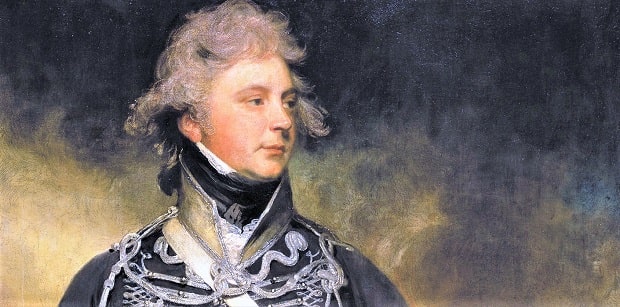George IV (Born on August 12, 1762, in London – Died on June 26, 1830, in Windsor) was the King of the United Kingdom and Hanover from 29 January 1820 until his death. From 1811 until his accession he was Prince Regent during the mental illness of his father George III.
George had an extravagant life that contributed to fashion during the Regency Period, being the patron of many forms of pleasure, style, and taste. He had a bad relationship with his father, accumulated large debts, and had several lovers, with the main and most enduring being Maria Fitzherbert.
He was forced to marry in 1795 with his cousin Carolina of Brunswick; the two disliked each other and separated shortly after the birth of their daughter Carlota of Wales the following year. Robert Jenkinson, 2nd Earl of Liverpool, controlled the government as prime minister for most of his regency and reign.
George’s governments, while receiving little support from the king, presided over victory in the Napoleonic Wars, negotiated a peace agreement, and tried to deal with the ensuing economic and social malaise. He had to accept George Canning as prime minister, in addition to giving up his opposition to Catholic emancipation.
His charm and culture earned him the title of “England’s first gentleman”, but his relations with George III and Carolina, and his wanton way, earned him the people’s contempt and diminished the monarchy’s prestige. Taxpayers were furious at their unnecessary wartime spending.
George did not provide national leadership in a time of crisis, nor did he act as a model for his people. Ministers rated his behavior as selfish, unreliable, and irresponsible.
Quick Facts: George IV
- Born: 12 August 1762, St James’s Palace, London, United Kingdom
- Also Known As: George Augustus Frederick
- Known For: The King of the United Kingdom and Hanover
- Reign: 29 January 1820 – 26 June 1830
- Coronation: 19 July 1821
- Predecessor: George III
- Successor: William IV
- Parents: Father George III of the United Kingdom, Mother Charlotte of Mecklenburg-Strelitz
- Religion: Protestant
- Spouse: Caroline of Brunswick (m. 1795; separated 1796)
- House: Hanover
- Died: 26 June 1830 (aged 67), Windsor Castle, Berkshire, England
- Burial: 15 July 1830, St George’s Chapel, Windsor Castle
The Early Life of George IV
Prince George was born at Saint James Palace in London on August 12, 1762; he was the first son of King George III and Queen Charlotte. As the eldest son of the British monarch, he automatically became Duke of Cornwall and Duke of Rothesay at birth; he was made Prince of Wales and Earl of Chester a few days after.
On September 18, he was baptized by the Archbishop of Canterbury, Thomas Secker. His godfathers were the Duke of Mecklenburg-Strelitz (his maternal uncle who was represented by the Duke of Devonshire, the Lord Chambellan), the Duke of Cumberland (his paternal double-great uncle) and Augusta of Saxe-Gotha-Altenburg (his paternal grandmother).

George was a talented student who quickly learned French, German, and Italian in addition to English. At the age of 18, he received a separate residence and in contrast to his father’s prosaic and slaveless life, he enthusiastically entered a life of debauchery involving the abuse of alcohol and numerous mistresses.
Drunk and sober, he excelled in the art of conversation and he had strong, albeit expensive, tastes in the decoration of his residence. This was a particularly serious lack of judgment given the extraordinary poverty of many Londoners, adults, and children, who lived on the streets.
Prince reached the age of 21 in 1783 and obtained a grant of £60,000 (about 82 million pounds in 2011) from Parliament and an annual grant of £50,000 (about 68 million pounds 2011) from his father. However, this was far too small compared to his needs; the stables alone cost £31,000 per year (around £42 million in 2011).
He then moved to Carlton House where he lived an extravagant life. The animosity increased between the prince and his father who wanted the heir to adopt a more austere lifestyle. The king of conservative was angered by the support of Prince Charles James Fox and other political radicals.
Regency crisis of 1788
It is largely consensus today that George III. was suffering from metabolic disease porphyria. This hereditary disease is associated with various symptoms and often runs in episodes. Mental confusion is one of the possible manifestations of this disease.
Because the British government system was still tailored to the king, his first serious illness was accompanied by a serious government crisis. George III suffered from mental confusion throughout the summer of 1788 but was able to postpone the opening of the Parliament from September 25 to November 20.
During this session break, however, the king’s condition continued to deteriorate. When parliament was to meet again in November, the king was no longer able to deliver the speech to the throne, which was mandatory at the beginning of a parliamentary period.
An opening of the parliamentary period was thus practically impossible. The Parliament ultimately decided to overrule this arrangement and began to debate the establishment of a regency. The ruling party and the opposition agreed that the Prince of Wales should take over.
However, since the two parties had a different understanding of the roles of parliament and monarchy, there was no agreement on the basis on which the reign was to be initiated. For the ruling Tories party, a reign of the Prince of Wales was also at risk of losing its influence.
William Pitt proposed a legal trick: the monarch was able to transfer many of his sovereign rights to a Lord Commissioner by affixing the Great Imperial Seal on one decree. Now the Lord Chancellor, the depositary of the Great Imperial Seal, was to apply the seal himself without the consent of the monarch.
The act itself was illegal and was sharply criticized by personalities like Edmund Burke, but the decree was valid because of the seal attached.
In February 1789, the Regency Bill was adopted by the House of Commons, which authorized the Prince of Wales to rule as Prince Regent. But before the House of Lords could also pass the law, George III. recovered from his illness again. The king subsequently recognized the legality of the procedure and again took over the official business.
Marriage to Caroline of Brunswick
The debts of the Prince of Wales, meanwhile, continued to grow and his father refused to continue helping him if he did not marry his cousin, Carolina of Brunswick. In 1795, by force or for love, the Prince of Wales agreed, and the couple married on April 8, 1795 in the Royal Chapel of St James’s Palace.
The marriage, however, was disastrous, as the two spouses were not in the least in love with each other. The two formally separated after the birth of their only daughter, Carlotta Augusta, in 1796, and remained separated for the rest of their lives. The prince always remained tied to Maria Fitzherbert.
Before resuming ties to Mrs. Fitzherbert closely, however, the Prince of Wales had had several illegitimate children. Among her most famous lovers, we remember Mary Robinson, an actress who was liquidated with a generous annual pension because she did not sell to the newspapers the compromising letters that the two had written during their union;

